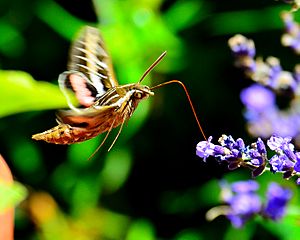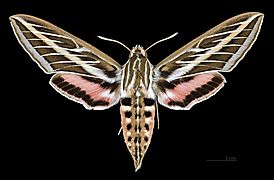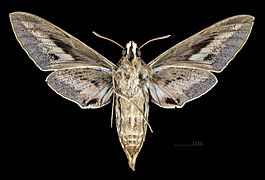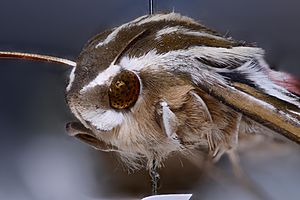White-lined sphinx facts for kids
Quick facts for kids White-lined sphinx |
|
|---|---|
 |
|
| Hyles lineata feeding | |
 |
|
| The caterpillar varies widely in coloration, from black with stripes to green with red spots. | |
| Scientific classification | |
| Synonyms | |
|
The Hyles lineata, also known as the white-lined sphinx, is a type of moth. It belongs to the Sphingidae family. People sometimes mistakenly call it a hummingbird moth. This is because it is quite large, with a wingspan of 2 to 3 inches. Its flight also looks a lot like a hummingbird's.
When these moths are caterpillars, they come in many different colors. But as adults, they always look the same. The white-lined sphinx lives across Central and North America. As caterpillars, they eat many different plants. As adults, they help pollinate various flowers.
Young caterpillars eat a lot. They can gather in huge groups. These groups can sometimes damage crops and gardens. Adult moths find flowers using both their sight and their sense of smell. They collect sweet nectar from these flowers.
Contents
- What the White-Lined Sphinx Looks Like
- Where the White-Lined Sphinx Lives
- Where the White-Lined Sphinx Makes its Home
- What the White-Lined Sphinx Eats
- How the White-Lined Sphinx Helps Plants (Pollination)
- Reproduction and Parental Care
- Social Behavior
- Life Cycle of the White-Lined Sphinx
- How the White-Lined Sphinx Works (Physiology)
- White-Lined Sphinx and Humans
- Gallery
- Images for kids
What the White-Lined Sphinx Looks Like
The Caterpillar Stage
The caterpillars of the white-lined sphinx come in many colors. Some are black with orange spots in lines along their body. Their head and a shield-like part near their head are one color. This can be green or orange, with small black dots.
A special feature is an orange horn sticking out from their back. This horn can also be yellow with a black tip. It is not a stinger and will not hurt humans. Some caterpillars are also lime green and black.
The Adult Moth Stage
The adult moth's front wings are dark brown. They have a tan stripe that goes from the base to the tip. White lines also show up on the wing veins. The back wings are black with a wide pink band in the middle.
These moths have a wingspan of 2 to 3 inches. They are large and have a thick, furry body. Their back has six clear white stripes. Their wings also have similar stripe patterns. The back wings are black with a thick, red-pink stripe.
Where the White-Lined Sphinx Lives
The white-lined sphinx is one of the most common hawk moths in North America. It lives in a very large area. This area stretches from Central America up to southern Canada. It includes Mexico and most of the United States. You can sometimes find them in the West Indies too. They have also been seen in parts of Eurasia and Africa.
The number of white-lined sphinx moths in certain places changes a lot each year. This change might affect how flowers look.
Where the White-Lined Sphinx Makes its Home
Because they live in such a big area, H. lineata can be found in many different places. These include deserts, gardens, and even suburbs. They are also often seen in the mountains of Colorado. However, their numbers there can vary from year to year.
What the White-Lined Sphinx Eats
Caterpillar Food
Caterpillars are known to eat many different plants, including:
- Willow weed (Epilobium)
- Four o'clock (Mirabilis)
- Apple (Malus)
- Evening primrose (Oenothera)
- Elm (Ulmus)
- Grape (Vitis)
- Tomato (Lycopersicon)
- Purslane (Portulaca)
- Fuchsia
- Clarkia elegans (Farewell to Spring)
Adult Moth Food
Adult moths drink nectar from flowers. They like:
- Columbines
- Larkspurs
- Petunia
- Honeysuckle
- Moonvine
- Bouncing bet
- Lilac
- Clovers
- Thistles
- Jimson weed
Adult moths choose different flowers based on when they are active. If they fly at night, they pick white or pale flowers. These are easier to see in the dark. If they fly during the day, they choose brighter colored flowers.
How the White-Lined Sphinx Helps Plants (Pollination)
H. lineata are important pollinators. They collect nectar from flowers. As caterpillars, they eat many kinds of plants. As adults, they prefer flower nectar.
A study from the 1970s looked at how H. lineata fed on Aquilegia coerulea flowers in Colorado. Some moths had pollen near their eyes, meaning they helped pollinate. Others had no pollen. The moths with no pollen had longer tongues. This suggests that some moths are better pollinators than others. Moths with shorter tongues seem to do most of the pollinating.
Other studies have looked at how these moths affect flower shapes. Moths visiting Aquilegia chrysantha flowers had tongues about the same length as the flower's nectar tube. This might mean the moths and flowers have changed together over time.
Hawk moths, including H. lineata, are known for their long tongues. They use these to reach nectar deep inside flowers. One study found that moths in northern areas had shorter tongues. This might be because it's easier to find food plants there. So, they don't need to fly as far or collect as much nectar at once.
Another study in 2009 showed that whiter flowers are often found where hawk moths are present every year. This means that the presence of H. lineata might lead to flowers becoming whiter over time. Hawk moths can affect how flowers look.
Reproduction and Parental Care
Adult H. lineata do not take care of their young. Females lay their eggs and then leave them.
Laying Eggs (Oviposition)
In the spring, female moths lay their eggs on different plants. These plants will become food for the caterpillars when they hatch. One female moth can lay hundreds of eggs in a single breeding season.
Social Behavior
Adult moths usually do not survive cold northern winters. But the caterpillars can survive winter. New moths start to appear in mid-May. If there are many moths, a second group might appear in late August or early September.
Caterpillars are known to gather in huge groups. They search for plants to eat together. They can eat whole plants and even cover roads. When they move in large groups, they can create a slippery mass.
Life Cycle of the White-Lined Sphinx
The way H. lineata searches for food changes. It depends on things like how high up they are, the temperature, and other factors. These things vary a lot across the wide area where they live.
Hyles lineata moths usually fly at night. But they sometimes fly during the day too. You can most often see them around dawn and dusk. Caterpillars survive the winter. They can come out between February and November. Then they start eating many different plants. Caterpillars are known to be very hungry eaters.
When a caterpillar is ready to change into a moth, it digs a shallow hole in the ground. It stays there for 2 to 3 weeks. Then, it comes out as an adult moth. As they get closer to changing, they wiggle closer to the surface. This makes it easier to emerge.
Usually, there are two generations of moths each year. But in warmer places, there can be more. Adult moths are mostly active at night.
Sometimes, huge numbers of these moths appear. This can force them to spread to more northern areas. This might explain why they live in such a wide northern range.
How the White-Lined Sphinx Works (Physiology)
As important pollinators, hawk moths use both their sense of smell and their sight. They use these senses to find and recognize flowers.
How They Fly
As mentioned, H. lineata are often called hummingbird moths. This is because they fly like hummingbirds. They flap their wings very fast. This lets them hover in front of flowers while they drink nectar. When feeding, hawk moths hover and use visual clues from the flowers to stay steady.
How They See
Hawk moths can be active during the day, night, or both. They all have three types of light sensors in their eyes. These sensors are sensitive to blue light, green light, and ultraviolet light. People used to think hawk moths mainly used smell to find flowers. This was because they often visited very smelly plants. But studies have shown that hawk moths actually have excellent vision. They are very sensitive to light.
How They Smell
Even though vision is very important for H. lineata, they also have a strong sense of smell. They are very sensitive to flower smells. They can also learn flower smells quickly.
White-Lined Sphinx and Humans
As a Food Source
At one time, Native Americans ate the caterpillars. After collecting them, they would put them on skewers and roast them for feasts. Any leftovers were stored whole or ground up after being dried.
As a Crop Pest
Caterpillars often form very large groups when looking for food. There have been reports in Utah of them damaging grapes, tomatoes, and garden crops.
Gallery
Images for kids
-
Yellow larvae in Arizona







